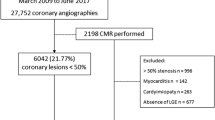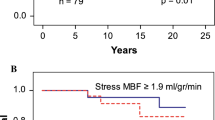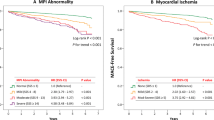Abstract
Late gadolinium enhancement (LGE) and myocardial perfusion study by cardiac magnetic resonance (CMR) have a diagnostic and prognostic value in patients with suspected coronary artery disease (CAD). The purpose of this study was to determine the prognostic value of combined myocardial perfusion CMR and LGE in patients with known or suspected CAD. We studied patients with known or suspected CAD. All patients underwent CMR for functional study, myocardial perfusion and LGE. Myocardial ischemia by CMR was defined as a perfusion defect in patients without LGE or a perfusion defect beyond the LGE area. Patients were followed up for cardiovascular outcomes including hard cardiac events (cardiac death or non-fatal myocardial infarction) and major adverse cardiac events (MACE) which included cardiac death, non-fatal myocardial infarction, hospitalization for unstable angina, and heart failure. There were a total of 587 men and 645 women. Average age was 64.6 ± 11.1 years. LGE was detected in 326 patients (26.5%). Myocardial ischemia by CMR was detected in 423 patients (34.3%). Average follow-up duration was 34.9 ± 15.6 months. Univariate analysis showed that age, diabetes, use of beta blocker, left ventricular ejection fraction, left ventricular mass, wall motion abnormality, LGE, and myocardial ischemia are predictors for hard cardiac events and MACE. Multivariable analysis revealed that myocardial ischemia was the strongest predictor for hard cardiac events and MACE. Other independent predictors were age, use of beta blocker, and left ventricular mass. Myocardial ischemia by CMR has an incremental prognostic value for cardiac events in patients with known or suspected CAD.


Similar content being viewed by others
References
Gibbons RJ, Araoz PA, Williamson EE (2010) The year in cardiac imaging. J Am Coll Cardiol 55(5):483–495
Wu KC (2009) Variation on a theme: CMR as the “one-stop shop” for risk stratification after infarction? JACC Cardiovasc Imaging 2(7):843–845
Kim HW, Farzaneh-Far A, Kim RJ (2009) Cardiovascular magnetic resonance in patients with myocardial infarction: current and emerging applications. J Am Coll Cardiol 55(1):1–16
Bulow H, Klein C, Kuehn I et al (2005) Cardiac magnetic resonance imaging: long term reproducibility of the late enhancement signal in patients with chronic coronary artery disease. Heart 91(9):1158–1163
Kim RJ, Wu E, Rafael A et al (2000) The use of contrast-enhanced magnetic resonance imaging to identify reversible myocardial dysfunction. N Engl J Med 343(20):1445–1453
Kwong RY, Chan AK, Brown KA et al (2006) Impact of unrecognized myocardial scar detected by cardiac magnetic resonance imaging on event-free survival in patients presenting with signs or symptoms of coronary artery disease. Circulation 113(23):2733–2743
Wu KC, Weiss RG, Thiemann DR et al (2008) Late gadolinium enhancement by cardiovascular magnetic resonance heralds an adverse prognosis in nonischemic cardiomyopathy. J Am Coll Cardiol 51(25):2414–2421
Nagel E (2009) Taking the last hurdles: magnetic resonance myocardial perfusion imaging. JACC Cardiovasc Imaging 2(4):434–436
Costa MA, Shoemaker S, Futamatsu H et al (2007) Quantitative magnetic resonance perfusion imaging detects anatomic and physiologic coronary artery disease as measured by coronary angiography and fractional flow reserve. J Am Coll Cardiol 50(6):514–522
Chiribiri A, Bettencourt N, Nagel E (2009) Cardiac magnetic resonance stress testing: results and prognosis. Curr Cardiol Rep 11(1):54–60
Hamon M, Fau G, Nee G et al (2010) Meta-analysis of the diagnostic performance of stress perfusion cardiovascular magnetic resonance for detection of coronary artery disease. J Cardiovasc Magn Reason 12(1):29
Doesch C, Seeger A, Doering J et al (2009) Risk stratification by adenosine stress cardiac magnetic resonance in patients with coronary artery stenoses of intermediate angiographic severity. JACC Cardiovasc Imaging 2(4):424–433
Mahrholdt H, Klem I, Sechtem U (2007) Cardiovascular MRI for detection of myocardial viability and ischaemia. Heart 93(1):122–129
Klem I, Heitner JF, Shah DJ et al (2006) Improved detection of coronary artery disease by stress perfusion cardiovascular magnetic resonance with the use of delayed enhancement infarction imaging. J Am Coll Cardiol 47(8):1630–1638
Boxt LM (1999) Cardiac MR imaging: a guide for the beginner. Radiographics 19(4):1009–1025 (discussion 1026–1008)
Cerqueira MD, Weissman NJ, Dilsizian V et al (2002) Standardized myocardial segmentation and nomenclature for tomographic imaging of the heart: a statement for healthcare professionals from the cardiac imaging committee of the council on clinical cardiology of the American heart association. Circulation 105(4):539–542
Wagner A, Mahrholdt H, Holly TA et al (2003) Contrast-enhanced MRI and routine single photon emission computed tomography (SPECT) perfusion imaging for detection of subendocardial myocardial infarcts: an imaging study. Lancet 361(9355):374–379
Alpert JS, Thygesen K, Antman E et al (2000) Myocardial infarction redefined—a consensus document of the joint European society of cardiology/American College of cardiology committee for the redefinition of myocardial infarction. J Am Coll Cardiol 36(3):959–969
Krittayaphong R, Saiviroonporn P, Boonyasirinant T et al (2007) Accuracy of visual assessment in the detection and quantification of myocardial scar by delayed-enhancement magnetic resonance imaging. J Med Assoc Thai 90(suppl 2):1–8
Nagel E, Lima JA, George RT et al (2009) Newer methods for noninvasive assessment of myocardial perfusion: cardiac magnetic resonance or cardiac computed tomography? JACC Cardiovasc Imaging 2(5):656–660
Ingkanisorn WP, Kwong RY, Bohme NS et al (2006) Prognosis of negative adenosine stress magnetic resonance in patients presenting to an emergency department with chest pain. J Am Coll Cardiol 47(7):1427–1432
Kwong RY, Sattar H, Wu H et al (2008) Incidence and prognostic implication of unrecognized myocardial scar characterized by cardiac magnetic resonance in diabetic patients without clinical evidence of myocardial infarction. Circulation 118(10):1011–1020
Schmidt A, Azevedo CF, Cheng A et al (2007) Infarct tissue heterogeneity by magnetic resonance imaging identifies enhanced cardiac arrhythmia susceptibility in patients with left ventricular dysfunction. Circulation 115(15):2006–2014
Nazarian S, Bluemke DA, Lardo AC et al (2005) Magnetic resonance assessment of the substrate for inducible ventricular tachycardia in nonischemic cardiomyopathy. Circulation 112(18):2821–2825
Yan AT, Shayne AJ, Brown KA et al (2006) Characterization of the peri-infarct zone by contrast-enhanced cardiac magnetic resonance imaging is a powerful predictor of post-myocardial infarction mortality. Circulation 114(1):32–39
Bansch D, Oyang F, Antz M et al (2003) Successful catheter ablation of electrical storm after myocardial infarction. Circulation 108(24):3011–3016
Tarakji KG, Brunken R, McCarthy PM et al (2006) Myocardial viability testing and the effect of early intervention in patients with advanced left ventricular systolic dysfunction. Circulation 113(2):230–237
Hachamovitch R, Di Carli MF (2007) Nuclear cardiology will remain the “gatekeeper” over CT angiography. J Nucl Cardiol 14(5):634–644
Lee DC, Simonetti OP, Harris KR et al (2004) Magnetic resonance versus radionuclide pharmacological stress perfusion imaging for flow-limiting stenoses of varying severity. Circulation 110(1):58–65
Rieber J, Huber A, Erhard I et al (2006) Cardiac magnetic resonance perfusion imaging for the functional assessment of coronary artery disease: a comparison with coronary angiography and fractional flow reserve. Eur Heart J 27(12):1465–1471
Iskandrian AE (2010) Stress-only myocardial perfusion imaging a new paradigm. J Am Coll Cardiol 55(3):231–233
Krittayaphong R, Boonyasirinant T, Saiviroonporn P et al (2009) Myocardial perfusion cardiac magnetic resonance for the diagnosis of coronary artery disease: do we need rest images? Int J Cardiovasc Imaging 25(Suppl 1):139–148
Patel AR, Antkowiak PF, Nandalur KR et al (2010) Assessment of advanced coronary artery disease: advantages of quantitative cardiac magnetic resonance perfusion analysis. J Am Coll Cardiol 56(7):561–569
Schwitter J, Wacker CM, van Rossum AC et al (2008) MR-IMPACT: comparison of perfusion-cardiac magnetic resonance with single-photon emission computed tomography for the detection of coronary artery disease in a multicentre, multivendor, randomized trial. Eur Heart J 29(4):480–489
Klein C, Gebker R, Kokocinski T et al (2008) Combined magnetic resonance coronary artery imaging, myocardial perfusion and late gadolinium enhancement in patients with suspected coronary artery disease. J Cardiovasc Magn Reason 10:45
Steel K, Broderick R, Gandla V et al (2009) Complementary prognostic values of stress myocardial perfusion and late gadolinium enhancement imaging by cardiac magnetic resonance in patients with known or suspected coronary artery disease. Circulation 120(14):1390–1400
Hombach V, Grebe O, Merkle N et al (2005) Sequelae of acute myocardial infarction regarding cardiac structure and function and their prognostic significance as assessed by magnetic resonance imaging. Eur Heart J 26(6):549–557
Korosoglou G, Elhmidi Y, Steen H et al (2010) Prognostic value of high-dose dobutamine stress magnetic resonance imaging in 1, 493 consecutive patients: assessment of myocardial wall motion and perfusion. J Am Coll Cardiol 56(15):1225–1234
Acknowledgments
The authors thank Dr. Pairash Saiviroonporn, Ms. Supaporn Nakyen and Mr. Prajak Thanapiboonpol for their technical assistance.
Conflict of interest
There is no conflict of interest involved in this study.
Author information
Authors and Affiliations
Corresponding author
Rights and permissions
About this article
Cite this article
Krittayaphong, R., Chaithiraphan, V., Maneesai, A. et al. Prognostic value of combined magnetic resonance myocardial perfusion imaging and late gadolinium enhancement. Int J Cardiovasc Imaging 27, 705–714 (2011). https://doi.org/10.1007/s10554-011-9863-9
Received:
Accepted:
Published:
Issue Date:
DOI: https://doi.org/10.1007/s10554-011-9863-9




